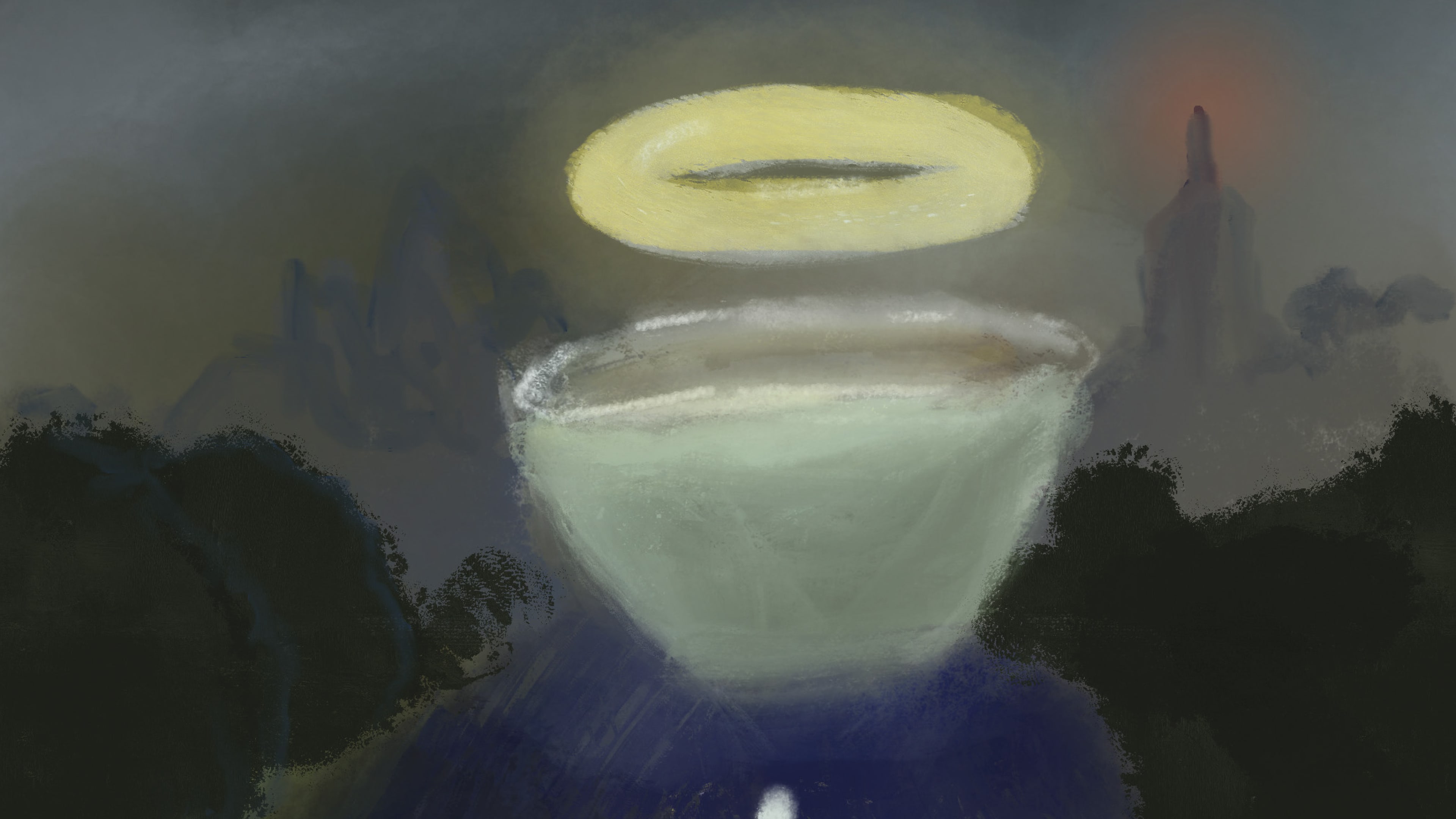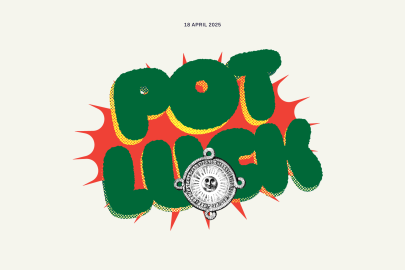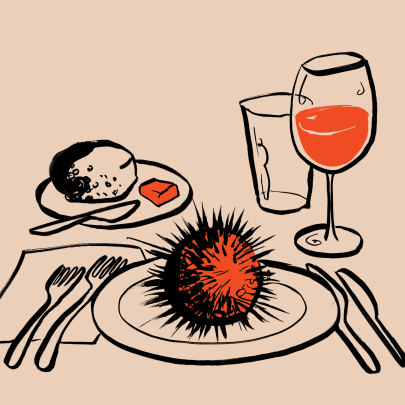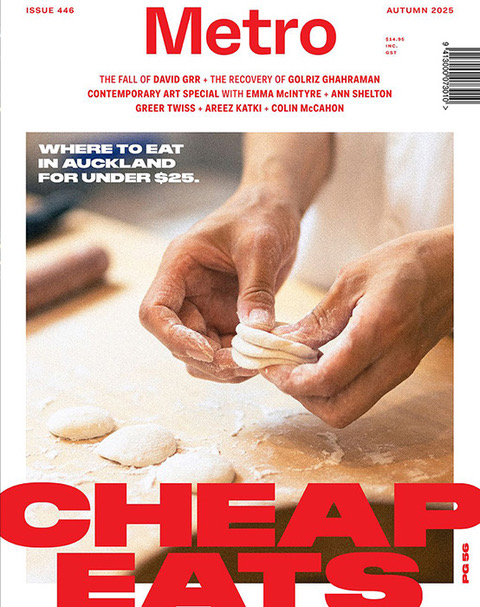Apr 1, 2025 Food
The daily coffee rituals practised by my Korean mother are my earliest memories of the drink. Each morning, she would carefully tear open a slim, bright-yellow, single-portion sachet of Maxim or French Cafe. She’d pour the crystals and powder into a small paper soju cup, a staple in every Korean household, then add boiling water. Using the now-empty plastic sleeve as a stirrer, she’d swirl the mixture into a milky, delicately brown, ultra-sweet brew. Years later, I found myself adopting the ritual, transporting the same packets on hiking expeditions up ancient mountains, to campsites in every corner of Aotearoa, and always keeping a tall box of bulk-purchased sachets in my pantry.
Three-in-one instant coffee mixes were first introduced to Korea in the 1970s. The innovative blend of powdered milk, sugar and coffee came in a single, convenient serving, and by the end of the decade the country was supposedly the largest consumer of instant coffee in the world. The popularity of these coffee sachets then grew intensely in 1997–98 during the Korean Financial Crisis (part of the wider Asian Financial Crisis), in which mass staff lay-offs resulted in the remaining office workers working longer and longer hours, fuelled by coffee they made themselves. As a child visiting Korea in the aftermath of the crisis, I thought the little packs of coffee were a recurring character in the story I was gleaning of the country. I’d spot them all over the place — available for self-service after dinner in traditional Korean restaurants, and in banks, dentists and waiting rooms across the land.
In Korea, coffee — beyond just the instant variety — has long been intertwined with both labour and leisure. Korea’s postwar economic miracle, from 1962 to 1980, saw a strong shift towards a fast-paced capitalist economy that created a time-poor workforce. In this climate, coffee (and cafes, too) became essential: sustaining office workers and students alike, providing both energy and necessary moments of social connection. It was only in 2011 that Korea adopted a five-day working week (initially Saturday was a half business day), and only in 2018 that the maximum weekly working hours were reduced from an unholy 68 to a far more manageable 52 (still high compared to the Western aspiration of 40 hours).
Students in Korea are also overworked, their entrance to university decided by a ‘life-defining’ exam that, in effect, goes on to dictate their careers and, ultimately, their lives. This is all to say that, in a culture where intense effort and long hours are the norm, it’s little wonder caffeine’s psychoactive properties encouraging wakefulness and focus have become so integral to the rhythms of everyday life.
The introduction of coffee to Korea dates back to 1896, when King Gojong took refuge in the Russian Legation in Seoul to escape Japanese threats. Korea’s first coffee shop was opened by Marie Antoinette Sontag, the sister-in-law of the Russian ambassador. These early cafes, or dabangs, began as elite spaces, later transforming into mainstream salons, especially after American troops spread coffee-drinking more widely during the Korean War. In the postwar years, dabangs became cultural hubs where artists, intellectuals and students gathered to argue, scheme, listen to records and, of course, drink coffee together. Some dabangs boasted an exclusive coffee/cream/sugar ratio, a concept which eventually led to that handily packaged instant coffee.
In recent years, Korea’s cafe culture has shifted, becoming more corporate and commercialised, by way of Korean-owned franchises (A Twosome Place, Ediya Coffee, Mega and Compose) alongside American giants (Starbucks and The Coffee Bean & Tea Leaf). Coffee is also consumed by way of omnipresent coffee-vending machines and pre-made convenience store products. Amid the expansion, in between the corporate cracks, independently owned specialty coffee shops have also emerged, helping to create an alternative Korean coffee identity — one that’s highly distinctive.
In Tāmaki Makaurau, a wave of Korean-owned cafes is redefining the local coffee scene, importing the nuances and particularities of Korean coffee culture while carving out a local identity. This shift — evident in the XX [7?] Korean-owned cafes in this year’s Top 50 list — is perhaps the most intriguing recent development in Auckland’s cafe landscape. Riding the momentum of Hallyu, the ‘Korean Wave’ that has taken global pop culture by storm through music, film, TV and cuisine, these cafes are introducing Aucklanders to a fresh point of Korean cultural influence: coffee.
From 1991, a new points-based system for immigration in Aotearoa finally changed the old preference for migrants from English-speaking countries (despite later tightenings of English-language requirements in 1995 and 2002), resulting in a wave of Korean migration alongside arrivals from other Asian countries. The topography of Korean cafes in Auckland today acts as a stand-in for the urban concentration of Asian populations in Tāmaki Makaurau. Cafes such as Rumours , Cosmo, Kompass and Receptionist Safehouse have settled into the lanes and peripheral streets of the central city; others, such as Holiday , Small Mercies , Handpicked Coffee Roasters and Cafe Ditto, have nestled into the urban fringe; and Bricks Roastery and Tob Coffee Roasters popped up on the North Shore. (Of these, Rumours, Receptionist, Holiday, Small Mercies, Handpicked and Tob are all Top 50 cafes this year.)
Across this cafe terrain, I see clear traces of the contemporary cafe culture I’ve seen in the coffee-obsessed Jongno District in Seoul. When you’re outside Korea, it can be difficult to pin down what it actually means for a cafe to be ‘Korean’ (beyond, of course, ownership). Hints at these connections are often found in the menu or the aesthetics of the spaces — elusive characteristics of a new contemporary identity that has moved away from the historical or traditional symbols more commonly emblematic of Korean culture.
Many of Auckland’s Korean-owned cafes have a distinctive, industrial, gallery-like atmosphere. On O’Connell St, Rumours Specialty Coffee has a minimalist interior with brutalist elements — matte-black finishes, concrete floors and a sparsely furnished layout of benches and compact tables. The emphasis is on standing room, creating spaces to perch and sip. A similar use of space can be seen at Mt Eden cafe Holiday (in fact, both cafes share the same interior designer, Studio WeAreYoung), with that spot’s plywood panelling, seating on the periphery and ample standing room for a revolving door of caffeine fiends. In Takapuna, Bricks Roastery, which opened in September, sports a contemporary aesthetic with burnt-red tones and a similar use of space to Rumours, Holiday and many independently owned cafes you’d find in Seoul. In these refined, industrial settings — starkly different from Auckland’s bright, edible-flower-laden brunch spots — specialty coffee is at the forefront.
Just up the road from Holiday is Small Mercies, which employs a cuter, more boldly colourful fit-out. With its multi-coloured plastic trays and bold patterned napkins, the cafe’s identity is a soft nod towards the Korean concept of aegyo, a focus on ‘cuteness’ or ‘adorableness’. Here, contemporary symbols associated with Korean culture are transported to Tāmaki Makaurau and subtly transformed, in an evolution towards an elastic, globally influenced style that reflects the dynamic spirit of the Tāmaki Makaurau diaspora.
Peruse a menu at any of these cafes and you’ll find more hints at their ‘Korean-ness’. Generally, this is by way of whatever coffee drink has been trending most recently in Korea. The country’s fast-moving culture latches swiftly on to new trends or crazes, contributing to the evolution of global coffee culture with its own homegrown twists and turns. The best-known example globally is probably whipped dalgona coffee (a mixture of instant coffee, sugar, hot water and milk), which was popularised and claimed by Koreans during the Covid-19 lockdowns despite having its roots in Macau (at a cafe called Wai Ting Coffee, which came to be known as ‘Hon Kee’ after its owner). The drink was then renamed ‘dalgona’ after a sweet Korean toffee candy. Affectionately reclaiming a coffee variant by giving it a nickname is common in Korean coffee culture. For instance, Koreans drink the beloved iced Americano even in winter, leading to the colloquial name ‘eoljukah’, a shortened version of the phrase, “Even if I freeze to death, iced Americano!”
Coffee drinks newly popular in Korea have found a place within local independent Korean cafes. The Vienna einspänner (an espresso topped with thick whipped cream), currently trending in cafes in Korea, can be found on the menu at Bricks Roastery, as well as at Kompass on Kitchener St in the central city, where they’ve developed their own twist by way of a strawberry matcha version. Lesser-known trends, such as ashotchu, the addition of an espresso shot to a slightly tangy, slightly bitter iced tea, can also be found in Tāmaki Makaurau cafes — in ashotchu’s case in the “signature” section of the menu at Bricks, where it is called the “Bricks drink”.
At Small Mercies there’s a banana milk matcha or espresso called Banana Kick — named after the banana-flavoured puffed corn that was my favourite childhood snack — and the cafe’s cabinet offers a range of sweet and savoury updates to kkwabaegi (twisted Korean doughnuts). Think yuzu and white chocolate; brown cheese with brown butter and maple glaze; and a personal favourite, cream cheese, chives and hot honey.
Beyond menus and design features, Korean cafe culture also tries to embrace the behavioural rhythms of daily life and its customers. The pocket-sized Cafe Ditto, in Eden Terrace, utilises its compact spatial footprint in a different way, filling the interior with tables. More unusually, Cafe Ditto often stays open until 9pm, reflecting the late closing hours common in Korea but rare in Auckland. Inside, patrons tap away on laptops, setting up a makeshift office or a space to congregate — a ‘third place’ recalling the late-night dabangs of an earlier time.
Korean coffee culture has always relied on evolving exchanges between East and West, from coffee’s introduction by Russian elites to its postwar rise as a beloved staple for Korea’s workforce. That culture continues to evolve — driven by artisans, trendsetters and regular coffee drinkers alike; fuelled by homegrown crazes and overseas influences. In Tāmaki Makaurau, these traditions find new life in new spaces, carrying forward the essence of the dabang and offering a liberating and, for the most part, democratic place for anyone in need of a break or a place to work. For some of us, too, it’s a quiet reminder of home — for under $10.






